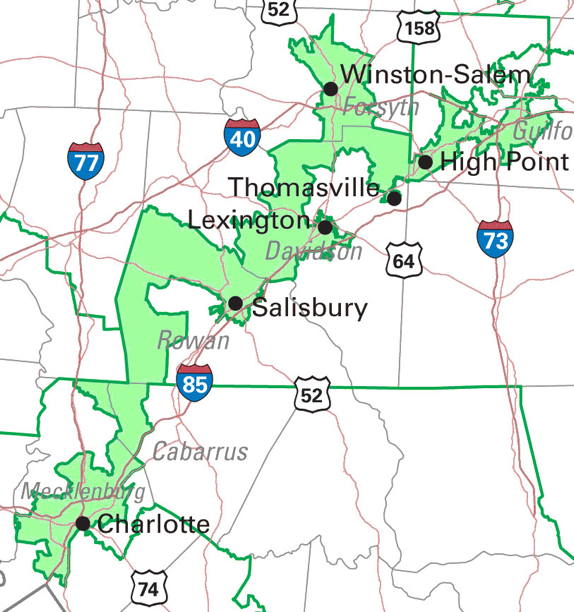Former US Supreme Court Justice John Paul Stevens has published a book in which he calls for certain amendments to the constitution, one of which is quite appealing:
1. Requiring that congressional and state legislative districts be “compact and composed of contiguous territory” to stop both parties from carving out safe seats.
US electoral districts can be particularly odd creatures. In a post from 2010, Zombie looks at the “top ten” gerrymandered districts … and they’re hard to believe. Here’s North Carolina-12, number 10 on the list:

This is what most people imagine when they think of a gerrymandered district — what I call “Gerrymander Classic.” NC-12 looks very much like the gerrymandered districts of the 19th century, but taken to extremes. As bad as it is, NC-12 at least looks like a congressional district, with meandering lines, consistent width, and hand-drawn appearance. As we’ll soon see, modern gerrymandering is often another animal altogether, with jarring shapes and artificial boundaries that are not just offensive to the eye but somehow feel like an insult to rationality.
Coming in at number 5, it’s Illinois-17:

Political scientists love to cite IL-17 as the prototypical gerrymandered district, and you are likely to see IL-17 used as the illustration in many academic treatises about redistricting. And we can see why here. Its shape has often been described as “a rabbit on a skateboard,” though to me it looks more like an embryonic ichneumon wasp with a pancreatic cyst. We saw above how PA-12 was a gerrymandering blunder by the Republicans; IL-17 is the opposite, a gerrymandered district created by Democrats to ensure themselves a seat in western Illinois — but which this year was snatched from their grasp by Tea Party candidate and now congressman-elect Bobby Schilling. Ooops! The Democrats went out on a limb when drawing IL-17 — several limbs, by the looks of it — but the wave election of 2010 changed the electoral landscape. Let me repeat my warning to over-confident redistricters next year: THINGS CHANGE. Gerrymander at your own risk.
And finally, the circa 2010 winner of the most gerrymandered district in the United States award, Illinois-4:

Here it is: The most ridiculous congressional district in the entire country. No, you’re not looking at two districts; IL-4 has two absurdly gerrymandered halves held together by a thin strip of land at its western edge that is nothing more than the median strip along Interstate Highway 294. The end result is a gerrymandered gerrymander, a complete mockery of what congressional representation is even supposed to be. As with AZ-2, the intention behind IL-4 was to create an ethnic enclave, in this case an Hispanic-majority district within an otherwise overwhelmingly non-Hispanic Chicago. Problem is, Chicago has two completely distinct and geographically separate Hispanic neighborhoods — one Puerto Rican, the other Mexican — but neither is large enough to constitute a district majority on its own. Solution? Lump all Hispanics together into a supposedly coherent cultural grouping, and then carefully draw a line surrounding every single Hispanic household in Chicago, linking the two distant neighborhoods by means of an uninhabited highway margin. Voila! One Hispanic congressperson, by design. And as a side-effect, the most preposterous congressional district in the United States.
The kicker? Those ten are at least legal in that they’re contiguous. Zombie goes on to show some even more outrageous examples where that requirement is blatantly ignored.






